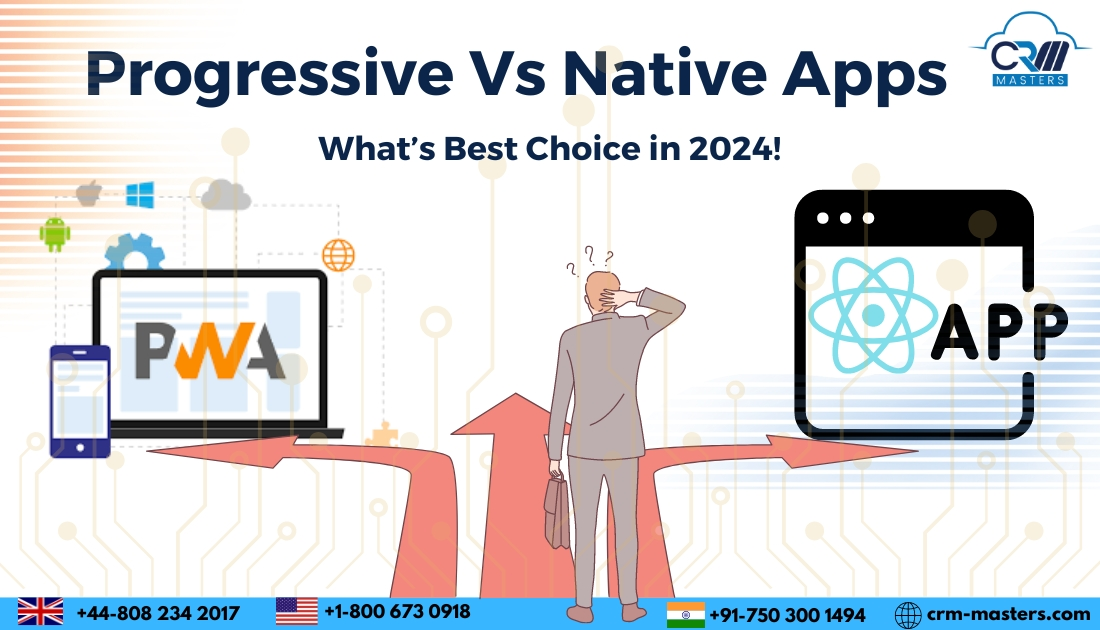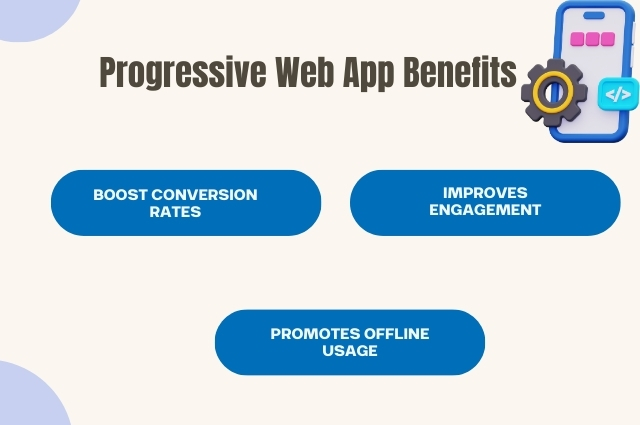
Progressive Web Apps(PWAs) Vs Native Apps: What’s the Best Choice in 2024
Mobile user experience is now more important than ever. If you want to provide the best experience to visitors visiting your website from their mobile devices, you have two options to choose from progressive web apps or native apps.
With the increased focus on mobile devices, users like businesses with mobile apps that promise a great mobile experience. Native apps provide an excellent mobile user experience (UX) and more features, while Progressive mobile apps enable you to deliver faster, Save costs, and reach users across multiple platforms.
Which is the best mobile app development for you? Is it a progressive web app or a native app? Let’s take a look at Progressive web apps vs. Native Apps and see which is better for your business development and user experience.
What is Progressive Web App?
Progressive Web Apps (PWA) are a type of web application that falls somewhere between a responsive web page and a mobile application. PWAs are mobile web pages that are built using modern JavaScript frameworks and are designed to function like native applications.
They can be easily added to the home screen of a mobile device with an icon. Just like an app, PWAs provide a full-screen user experience to engage the user. With the help of Service Workers, some of the advantages of native apps are available to PWAs, but these are still limited, especially on iOS.
In 2015 by Google, PWA technology enhances the mobile web user experience and provides the following benefits:
- Boosts Conversion Rate and Retention:- According to industry research, progressive web apps load faster, help users quickly find information, and can save users up to 40% more time.
- Improves Engagement:- PWAs can be leveraged to increase engagement via push notifications and mobile device load times.
- Promotes Offline Usage:- PWAs can operate on poor connections and offline (because of pre-caching) so that the website loads consistently and is never offline.
What is a Native App?
A native mobile application is a mobile application that is installed from an app store on an iOS or Android device. A native mobile application is designed to take advantage of the hardware of a specific mobile device and provide an enjoyable user experience.
Because native apps are designed for a particular operating system, their hardware’s features work more efficiently. Native apps are designed specifically for the iOS and Android operating systems, they are developed separately from each other. This leads to more investments in terms of resources, time, and effort. Additionally, the launch of a native mobile application requires approval from app stores, as well as extensive app store optimization for marketing and success.
PWAs Vs Native Apps Which One’s Better?
Both Progressive Web Apps (PWA) and Native Apps (NA) have their advantages and disadvantages, but which one should you create for your business? Here are a few tips to help you decide between PWA and a native app:
For Businesses
1) Time to Market
If you’re still in the early stages of development and want to deliver fast, PWAs may be right for you. However, the native apps approach necessitates dedicated development teams for Android and iOS app launches. Additionally, the approval process from app stores may take longer than anticipated.
2) Cross-Platform Availability
If you’re trying to reach a larger audience or your target market is segmented, you won’t be able to launch native apps for both Android and iOS. You’ll need to design and build the apps for both platforms separately to reach your target audience and provide a better mobile experience, but you’ll have to spend more time and money.
Progressive Web Apps (PWA) are being built to be responsive. They make it easy (and fast) to connect with users, regardless of where they are on the web. PWAs can increase engagement rates exponentially due to their faster accessibility.
3) Cost of Development
Native apps are expensive to develop because you need to develop both versions of the app separately if you want to have native features.
For Android native app development, Java and Kotline are used. For iOS native app development, Objective-C/Swift is used. Having two different development tech stacks means more team members and higher development costs. Different codebases also lead to higher maintenance costs. This high cost is a risk factor for early-stage startups who want early traction and real users.
On the other hand, creating a Progressive app is simpler and cheaper because it’s a web app that’s built to work as an app on any device, regardless of the platform.
Also Read: Why do Google & Microsoft Need a Progressive Web Application?
For Users
Your users are important to your business and growth. Therefore, the choice between a progressive web app or a native app is incomplete without considering the advantages and disadvantages from the user’s point of view. Let’s take a look at how they stack up from the end-user’s viewpoint.
1) Download and Installation
Mobile users like simple workflows and easy-to-use applications. Not all users want to install an app for information or a one-time use; most are looking for an on-the-go solution. With growing privacy worries, users are cautious about giving a native app permission to access their phone storage location, etc.
PWAs give you an advantage. Unlike native mobile apps, a user does not need to install a Progressive web app to search for information, interact with a business, or even make a purchase.
In terms of ease and convenience, PWAs outperform native apps by far. They save time and reduce the amount of storage space on your device. PWAs are hybrid apps that are always available for both iOS and Android.
2) Features and Functionality
A native app can offer more features and functionality than a PWA. Features such as geofencing, NFC mobile payments, cross-app features, and smart sensor usage are not available in a PWA.
In addition, push notifications cannot be delivered via a Progressive web app on iOS. It requires a native app. Therefore, if you want to use push notifications or other features mentioned above, you should consider using native apps instead.
3) Performance
However, progressive web apps load more quickly, but they also use a third-party web browser. As a result, there will always be a risk of latency and heavy battery consumption.
In contrast, a native application integrates seamlessly into the smartphone as soon as it is installed. A native application can take advantage of the hardware and features of the smartphone better than a PWA. Native mobile applications are also more powerful and perform well due to the platform-oriented code.
4) Offline Availability
Progressive web apps (PWA) can provide offline functionality by delivering specific parts of the web application at a time. If the user asks for any information that is not part of the natural cache, then PWAs have restrictions. For example, you can view static pages in the app but not submit a form until the app is reconnected.
In contrast, native apps do much better in this regard. A native application will provide a consistent experience even if the user is not online 24×7.
Detailed Comparison list of PWA vs Native App
| S.No. | Features | PWA | Native APP |
| 1 | Installation | No installation is required. | Download from App Stores |
| 2 | Limited Access | Limited Access | You will be able to have full access to all hardware features as well as custom system settings. |
| 3 | Offline Mode | While pre-caching makes it possible to use your application offline, PWAs have only a limited offline capability. |
Offline Mode is now available. |
| 4 | Updates | Automatic and Immediate Updates | User Manual Updates |
| 5 | Security | HTTP encryption | Depending on the device and operating system, additional security layers can be added. |
| 6 | Push Notifications | It is not possible to use on iOS devices | Available on all Platforms |
Also Read: How Salesforce Mobile App Benefits Your Business?
Summarizing Progressive Web Apps Vs Native Apps
We have covered most points that illustrate the difference between native web apps and progressive web apps (PWAs). Both native web apps and PWAs provide significant improvements in user experience compared to traditional mobile responsive websites. However, there are clear advantages and disadvantages between the two solutions
Below is a brief overview of the key advantages of each:
Advantages of Progressive Web Apps
- Lower maintenance costs
- Discoverable Via Google Search
- Simplest and fastest
- It can be installed on a user’s device (although not as easily as native apps)
- You may only be able to use push notifications in certain browsers and operating systems.
Advantages of Native Apps
- More secure
- It can be used offline
- Enable the use of device functions (GPS and camera)
- This gives you access to the Google Play and Apple App Store.
- Easy, one-tap installation
- This app allows you to take full advantage of push notifications.
PWAs are easier to use and more cost-effective than native apps. They also provide better performance than mobile websites. On the other hand, native apps provide more overall power and a better overall user experience.
What’s the Best Choice PWAs or Native Apps
When it comes to mobile app development for a startup or business, you don’t want to make a hasty decision. You want to consider all the advantages and disadvantages before deciding whether to develop a native application or a Progressive web app.
If your users value their time and data, a progressive web application is the way to go as it doesn’t require downloads. However, if you have complicated features and want to stand out in the app stores for brand trust, You can choose a native app.
Both apps have their unique features according to your requirements. Whether you select Progressive Web apps or Native Apps both apps can match your expectations.
Still Confused! Which app is better for your Business?
With the guidance of CRM Master’s Infotech, you can select the right app that is well-suited for your users and your budget.
Sweet Bonanza 1000 shining crown Shining Crown matbet Sweet Bonanza 1000 Fortune Rabbit pusulabet İmajbet













